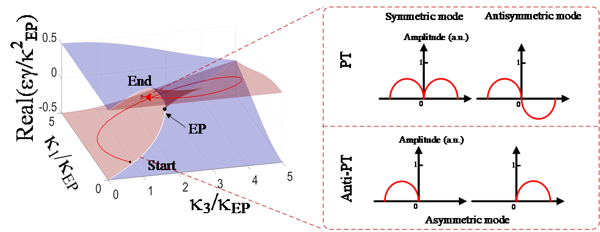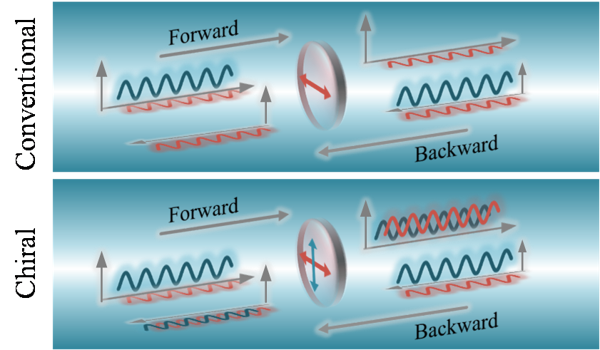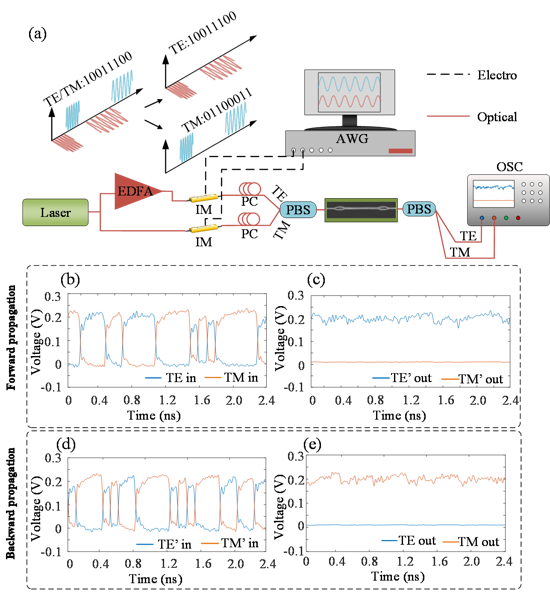Parity-time (PT) symmetry, as a physical concept, describes the special and temporal symmetry of the physical quantity. Recent year, it has been discovered that PT symmetry can be easily observed in the photonics system. Exceptional point (EP) is a particular point in the PT symmetric system, at which the eigenvalues and eigenvectors degenerate. Plenty of counterintuitive phenomena have been observed around EP. Specially, owing to the non-Hermiticity induced nonadiabatic transitions, chiral mode switching was achieved by encircling the exceptional point (EEP) in a PT symmetric system.
However, this chiral dynamic is based on the coupling of spatial mode so far, and has never been realized on the polarization dimension. Because of the asymmetric property of polarization, it is unsuitable to perform the EEP based on polarization coupling in a PT symmetric system, as shown in Fig.1.

Fig.1. The difference between the start points of encircling EP in the PT/anti-PT symmetric system.
Consider the wide application of polarization, the asymmetric polarization switching could play an important role in polarization manipulation. It is worth to find a well-matched system to realize the asymmetric polarization switching. As the counterpart of PT symmetry, anti-PT symmetry also demonstrates plenty of novel properties. The start point of encircling EP in the anti-PT symmetric system is asymmetric, which makes it a perfect system to construct chiral polarization switching.
Recently, the research group led by Prof. Xinliang Zhang from Huazhong University of science and technology, reported a chiral polarizer based on encircling EP in an anti-PT symmetric system. By combining the anti-PT symmetric system and polarization modes based EEP evolution, the asymmetric polarization switching can be realized. This interesting phenomenon can be applied as a chiral polarizer, which demonstrates different polarization properties for propagation forward and backward. However, a conventional polarizer will eliminate the undesired polarization component, and the polarized transmission axes keep unchanged for bidirectional propagation. The research results were published in Photonics Research, Volume 10, No. 1, 2021 (Yanxian Wei, Hailong Zhou, Yuntian Chen, Yunhong Ding, Jianji Dong, Xinliang Zhang. Anti-parity-time symmetry enabled on-chip chiral polarizer[J]. Photonics Research, 2022, 10(1): 01000076).
The proposed chiral polarizer will rotate the cross polarization state to the transmission axis, and exhibit different transmission axes for forward and backward propagation, as shown in Fig.2. A 10 dB extinction ratio between the transverse electric (TE) mode and transverse magnetic (TM) mode has been achieved over a bandwidth from 1530 nm to 1570 nm.

Fig.2. The difference between conventional polarizer and chiral polarizer.
When propagation forward, arbitrary polarization will be converted to TE mode. However, when propagation backward, TM mode will become the dominant output mode. The device is designed on the conventional silicon-on-isolator (SOI) platform, and the fabrication is complementary metal-oxide-semiconductor (CMOS) compatible. The proposed chiral polarizer combines the anti-PT symmetry and asymmetric polarization switching together, provides a new application scenario for the encircling EP asymmetric mode switching.
To further demonstrate the application of the chiral polarizer, a communication experiment has been done to perform a function of polarization encoded information formatting, as shown in Fig.3. A 10 Gbit/s on-off keying data stream, in which TE represent '1' and TM represent '0', are injected into the chiral polarizer. In forward propagation, the output polarization state will be converted into the horizontal direction no matter what the input polarization states are (Fig. 3(b) and 3(c)). However, in backward propagation, the output polarization state will be converted into the vertical direction (Fig. 3(d) and 3(e)).

Fig.3. The communication experiment. (a) The experiment setup. (b-e) The waveform received by the OSC.
This work demonstrates the asymmetric polarization switching based on EEP in an anti-PT symmetric system, and applies it as a chiral polarizer. It is the first time the asymmetric polarization switching is demonstrated. More importantly, a practicable application of asymmetric mode switching based on EEP is demonstrated. Future works will focus on the further optimization of the device to reduce the insertion loss and exploit the potentials of PT and anti-PT symmetric system.


